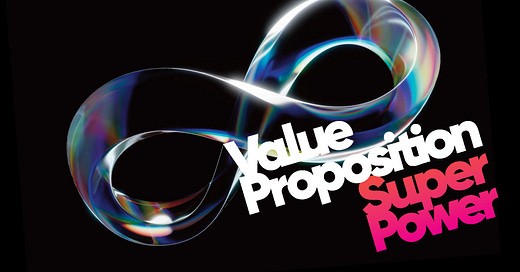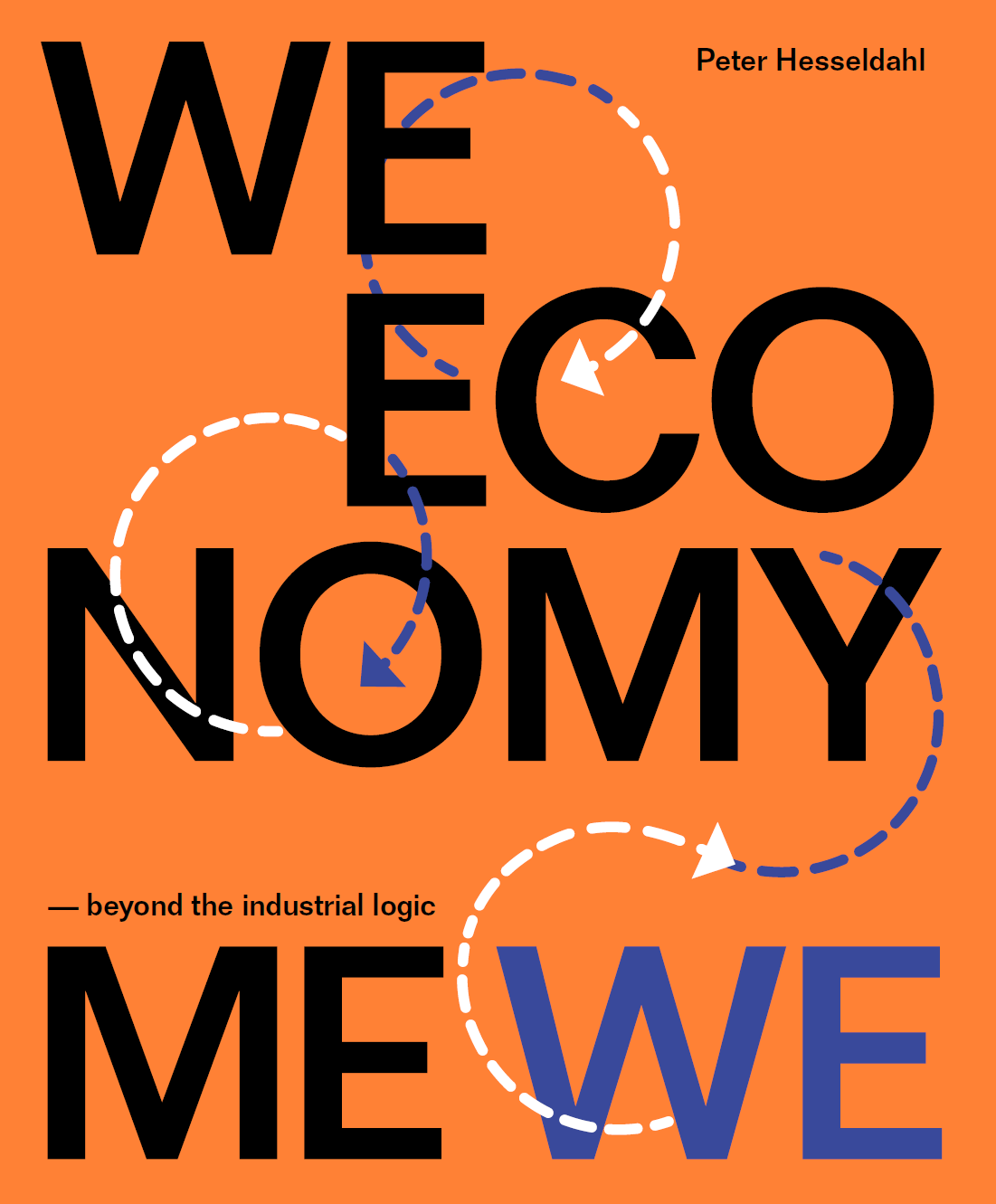Roll up! Roll up! Introducing the 21st century's unprecedented Customer Value Mode.
It makes for what you might call an interesting life!
CUSTOMER VALUE - it’s the subject I’ve focused on most throughout my working life: that is, the Value that a Customer experiences in any situation.
Well, that was the state of play up until the late-20th century. Since that time, however, Customer Value has increased its range. Around a decade ago, the penny finally dropped (for me, anyway … maybe you got there earlier?) that the world of transactions was dwindling and something else was coming to the fore. We were standing on the doormat of a world of interactions!
It’s a subtle but profound distinction and, since all of us - You. Me. Everyone. - are engaged in interactions every day of our lives, Customer Value becomes hugely relevant to all of us on a far broader basis than once was the case.
To introduce this topic, I shall unashamedly start from basics. Here goes …
Back in the 20th century what we label Customer Value was almost exclusively communicated to us via a sort of broadcast process carried out by the manufacturer or provider of a good or service. Not least, therefore, it was always contained within a Business context, and was limited to issues arising within an acquisition process. It was, therefore, exclusively the stuff of Business and of those two entangled Business functions, Sales and Marketing. Now, however, it has moved beyond - way beyond - what we once understood as the borders or limits of those two domains.
Put it another way: Customer Value broke out of The Business Box (and started stomping around in the other two major domain boxes: The Politics Box and The Societal Box - but more about this next time).
In the process, Sales and Marketing really have become so inter-connected that, to succeed, they really must learn to function seamlessly together, and together with their customers and a range of other stakeholders.
The Go-to-Market approach tackles this issue but, still, for many enterprises, failure to understand the situation must inevitably perpetuate the unfortunate tendency for Sales and Marketing to behave like those two irascible characters, Tweedledum and Tweedledee:
‘I know what you’re thinking about,’ said Tweedledum: ‘but it isn’t so, nohow.’
‘Contrariwise,’ continued Tweedledee, ‘if it was so, it might be: and if it were so, it would be: but as it isn’t, it ain’t. That’s logic.’1
Now then, back to basics …
The world changed. “The world is always changing,” I hear you say. And, of course, you are right. But, if you’ll forgive my obtuseness, there are changes and there are changes.
So, what is it that was so especially world-changing about whatever it is that happened on this occasion?
This is where it all started …
The technologically-enabled shift, born at the dawn of the 21st century, from supply chains to networks, from Broadcast to Interaction, wasn’t just any old change. It was a MEGA-CHANGE and a META-CHANGE.
For a start, and most fundamentally, it changed the conversation.
The Industrial Age broadcast model was a linear, one-way process that nearly always promised:
“We provide great products that are better than those of our competitors. Buy them because your life will be incomplete without them.”
Then, suddenly, there was a New Age interaction model that was different. It promised:
“We work hard to make great products for people like you. To continue to do so, we’d like to work with you to ensure that we satisfy your current and future needs. We can only do that by inviting you in to our world. Use our systems and processes to engage with us. You can directly access whichever of our people are most appropriate to your and our needs.”
Ten or so years ago that was about as far as my understanding of the situation went. Seven years ago, thanks to several conversations with Peter Hesseldahl, who wrote his book We-Economy 2 at the time, I began to glimpse the wider implications of it all.
But it is only now, coming back to the subject, that the bigger picture seems clearer.
For one thing, the MEGA- and META-CHANGE benefited hugely from the fact that, in the West, at least, as the 20th century had progressed, conditions had more and more favoured a ‘Market’ view of Everything.
It all resulted, in that brief period of certainty in the final decade of the 20th century following the collapse of the Soviet Union, in liberalism ruling the day. The West had won! It was, as Francis Fukuyama put it, “the end of history”. And, in those heady conditions, the Market appeared to personify …
… the cardinal principle of liberalism that individuals are the best judges of their own interests and that they must therefore be allowed to speak for themselves in matters that concern their happiness and well-being.3
The trend had been there throughout the second half of the 20th century. In education, for example, where students effectively morphed into Customers of the institutions that they attended. And - a more subtle shift, this - in public transportation where people once known as ‘passengers’ became ‘customers’.
This may seem all well and good but, as Lasch commented …
… individuals cannot learn to speak for themselves at all, much less come to an intelligent understanding of their happiness and well-being, in a world in which there are no values except those of the market.4
In future scribblings I shall return to some of the meta issues but, for now, let’s just say that although some of the changes have arguably given Business too much power (way too much power, some would say), they have happened and we have to deal with the here and now.
So, back to my main point for this particular scribbling: what changes if any have occurred in the way Customer Value is understood and delivered?
To start, I’m going to take the opportunity to pay homage to the work of a dear friend, John Frazer-Robinson (known to all as JFR), known best for his pioneering work in direct marketing:
Which makes more sense to you? Consider the choices:
the machine itself – a first-generation product;
the machine tailored to your specification or with the added value of skill opportunities to get the best out of it;
or the machine designed to do a better job for you tomorrow because it is the result of a team effort involving the brains at the buying company and the brains at the manufacturer?5
That succinct list is a very nice summary, particularly considering the fact that it was compiled way back in the 1990s.
A few years after that, Drs Stephen Vargo and Robert Lusch published a paper6 that identified what they termed Goods-Dominant Logic (G-D logic). Here’s their definition of G-D logic:
Consider an automobile. A manufacturing firm constructs an automobile out of metal, plastic, rubber, and other parts, arranges them precisely, and packages them together. In their raw form, the metal and other components cannot be used as transportation. According to G-D logic, the firm’s production process creates value for customers through the manufacturing and delivery of an automobile. That is, the automobile manufacturing firm embeds value in the automobile by transforming raw materials into something that customers want. In this sense, value is created by the firm in the form of a good, and this valuable good is exchanged in the marketplace for money (or possibly other goods). Value is measured by this exchange transaction.
This, the original basis of ‘goods for sale’, had things all its own way for a long time, from the start of the Industrial Revolution right through to the late-20th century. Then a new concept came on the scene and, in 2008, in On value and value co-creation, Steve Vargo teamed up with Paul Maglio and Melissa Akaka to address the arrival of Service-Dominant Logic (S-D logic). Here’s their definition:
In S-D logic, the roles of producers and consumers are not distinct, meaning that value is always co-created, jointly and reciprocally, in interactions among providers and beneficiaries through the integration of resources and application of competences. Consider the automobile again. As before, a manufacturing firm applies its knowledge, skills, and capabilities to transform raw materials into an automobile. But according to S-D logic, the automobile is only an input into the value creation that occurs as a customer uses it (in transportation, self-identity, etc.) and integrates it with other resources. If no one knew how to drive, had access to fuel and maintenance, and functioned in social networks for which particular automobiles had particular meanings, etc., the car would have no value. It is only when the customer makes use of the automobile – in the context of his or her own life – that it has value. 7
What this expresses is a shift from an objective view of Value to a subjective view. Value, like Beauty, is in the eye of the beholder.
So, is that it? Has the evolutionary process reached a stable point, at least for a time?
No.
Already we have moved beyond this point. It’s where we are forced to come back to the MEGA- & META-CHANGE that I referenced earlier. But more about that next time.
Thus far, the above definitions relate to:
Gen 1: Goods-Dominant Logic … Value in Exchange … ViX
Gen 2: Service-Dominant Logic … Value in Outcome … ViO
But we are already seeing a new variant. I style it as follows:
(Drum roll …)
Gen 3: Compatibility-Dominant Logic … Value in Association … ViA
I’ll expand on this as we go along - including the definition of Compatibility-Dominant Logic. For now, however, let me just state a couple of absolutely crucial points:
When a new Customer Value generation comes along, it does NOT wholly replace what has gone before. ViX, ViO and ViA are all currently in operation. As customers, we all mentally hop from one value mode to another depending upon what is being considered and the circumstances that prevail at the time. To be successful, a supplier needs to work out how to address these variations.
ViA is very different from what has gone before because it breaks out of the old Customer Value mould to take into account elements that have nothing whatsoever to do directly with the product or service in question.
As you’ll appreciate, these qualifiers can make for some very tricky operational decisions.
We’ll talk more about it next time in this series.
Thanks for reading.
The Value Proposition Super Power image at the top is by Paul Bagshawe (1962-2024). He is sorely missed.
Lewis Carroll. Through the Looking-Glass and what Alice found there (1871)
Peter Hesseldahl. We-Economy: beyond the industrial logic (2018)
Christopher Lasch. The Revolt of the Elites (1996)
Christopher Lasch. Ibid.
John Frazer-Robinson. Customer-Driven Marketing (1997). Second edition published as It’s All About Customers (1999)
Stephen L. Vargo & Robert F. Lusch. Evolving to a New Dominant Logic for Marketing, American Marketing Association Journal of Marketing (January 2004)
Stephen L. Vargo; Paul P. Maglio; Melissa Archpru Akaka. On value and value co-creation: a service systems and service logic perspective (2008)






